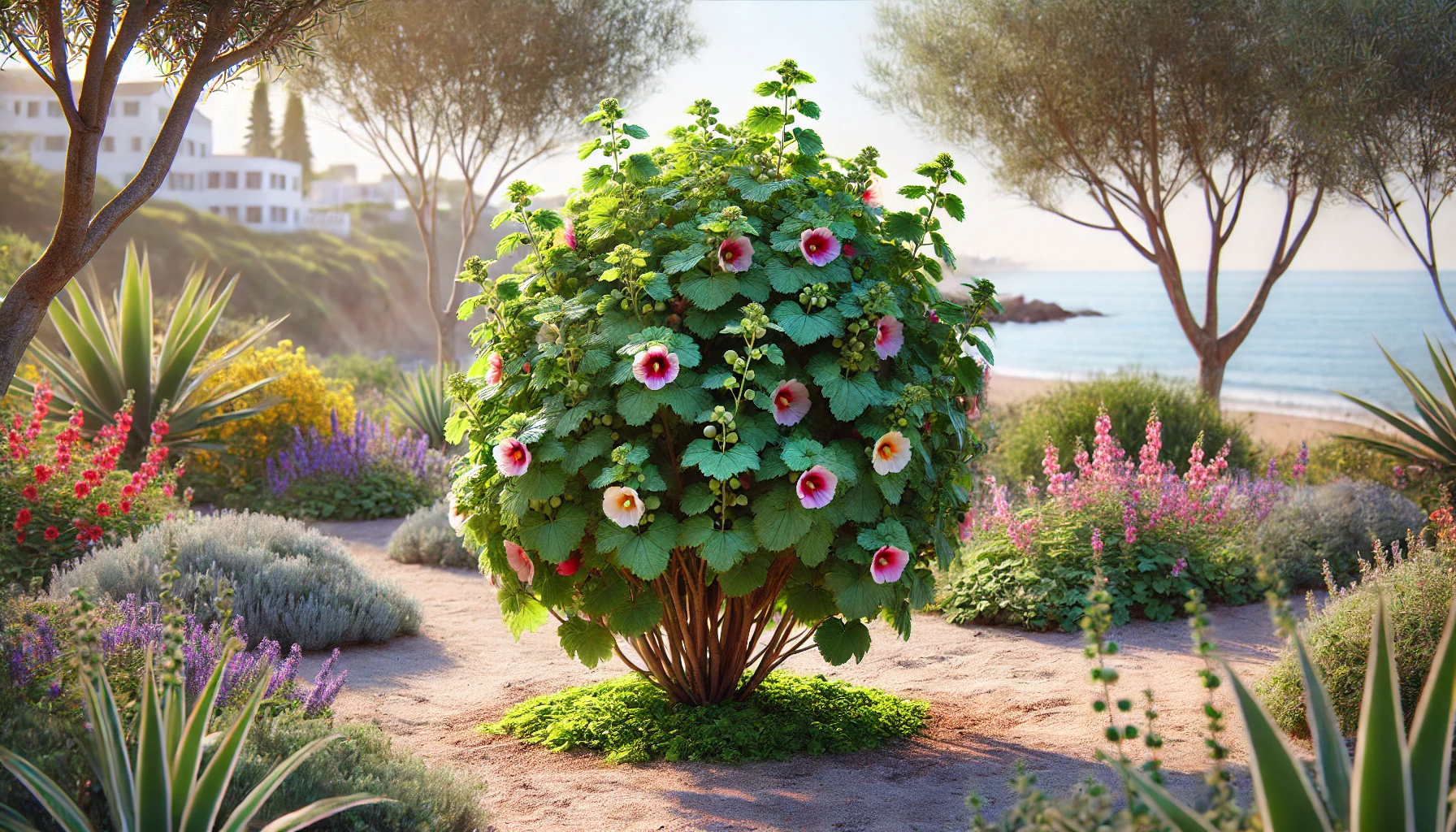
Tree Mallow (Malva arborea), also known as Lavatera arborea, is a hardy perennial shrub that can grow up to 10 feet (3 meters) tall. With its large, vibrant flowers and attractive foliage, it’s a great choice for coastal gardens and landscapes that need a splash of color. This fast-growing plant blooms throughout the summer and into fall, creating a lush, beautiful presence in your garden.
History and Ideal Growing Conditions
Native to the Mediterranean region and coastal areas of Europe, Tree Mallow thrives in mild climates, particularly those with maritime influence. It’s commonly found in coastal areas due to its salt tolerance, making it ideal for gardens near the sea.
Tree Mallow prefers USDA hardiness zones 7 to 10, where winters are mild, and summers are temperate. It does best in full sun but can tolerate partial shade, particularly in hotter climates. The plant grows quickly in well-draining soil and is drought-tolerant once established, making it a resilient option for a range of garden conditions.
Toxicity and Pets
The Tree Mallow is non-toxic to pets, making it a safe option for gardens where animals may roam. It is not harmful if chewed or ingested by cats, dogs, or other animals.
Safe Alternatives
If you’re looking for other safe, non-toxic plants with a similar appearance, consider Rose of Sharon, Hibiscus, or Snapdragons. These plants also provide vibrant blooms without posing a threat to pets.
Best Practices for Caring for Tree Mallow
While Tree Mallow is relatively easy to care for, paying attention to a few key elements will ensure it thrives in your garden.
Watering and Humidity
Tree Mallow is drought-tolerant, but regular watering during its first growing season is important for establishing strong roots. Water the plant deeply once a week, allowing the soil to dry out slightly between waterings. In dry or hot climates, you may need to water more frequently. Humidity isn’t a concern for this plant, making it suitable for both humid and dry environments.
Soil, Light, and Temperature
Tree Mallow prefers well-draining soil, but it can tolerate a variety of soil types, including sandy or loamy soils. It’s adaptable but thrives in slightly acidic to neutral pH levels. Full sun is essential for the best flowering, though it can tolerate light shade.
As for temperature, Tree Mallow thrives in regions with mild winters. It can handle temperatures down to 10°F (-12°C), but in colder regions, it may act more like a biennial. Mulching the base of the plant in winter will help protect its roots from frost.
Fertilizing
Fertilize Tree Mallow in the spring with a balanced, slow-release fertilizer. You can also use compost to enrich the soil. This plant isn’t a heavy feeder, so avoid over-fertilizing, as this can lead to excessive foliage growth at the expense of blooms.
Common Problems and Remedies
Tree Mallow is relatively resistant to pests and diseases, but it can encounter a few issues. Powdery mildew is the most common problem, particularly in humid conditions. Ensure the plant has good airflow by spacing it properly and avoiding overhead watering.
Aphids and spider mites may also appear, though they can typically be managed with insecticidal soap or neem oil. Regular pruning to remove diseased or damaged leaves can help prevent problems.
Invasive Species Concerns
In some regions, particularly coastal areas, Tree Mallow can spread quickly and become invasive. If you’re in an area where this plant is considered invasive, control its spread by removing seed heads before they set seed or opting for non-invasive alternatives.
Safe Alternatives
If Tree Mallow is invasive in your region, consider planting Hardy Hibiscus or Rose of Sharon. These plants offer similar beauty without the risk of spreading uncontrollably.
Pruning for Tree Mallow
Pruning Tree Mallow helps maintain its shape, promote healthy growth, and encourage flowering. Prune in late winter or early spring before new growth begins.
Tools Needed
Use sharp, clean pruning shears or loppers for cutting back branches. Always sanitize your tools before and after use to prevent the spread of disease. A solution of rubbing alcohol or bleach works well for this purpose.
Identify Areas to Trim
Start by removing any dead or damaged branches near the base of the plant. You can also thin out the canopy to improve air circulation. Cut back leggy branches to about one-third of their length to encourage bushier growth.
Deadheading
Remove spent flowers throughout the blooming season. Deadheading encourages continuous blooms and prevents the plant from putting energy into seed production.
Prune Leggy Growth
If your Tree Mallow becomes leggy or untidy, prune back the branches by one-third to promote a fuller, more compact shape.
Remove Damaged or Diseased Leaves
Inspect the plant regularly for any signs of disease or damage, such as yellowing or wilting leaves. Remove these leaves immediately to prevent the spread of disease.
Shape the Plant
After pruning, assess the overall shape of the plant. Trim back any uneven growth to maintain a balanced appearance.
Post-Pruning Care
After pruning, water the plant deeply to help it recover and apply a fresh layer of mulch around the base to retain moisture and regulate soil temperature.
Propagation and Benefits
Tree Mallow can be propagated by seeds or cuttings. For cuttings, take a 6-inch (15 cm) cutting from a healthy branch in early summer, remove the lower leaves, and plant it in well-draining soil. Keep the soil moist until roots develop.
One of the benefits of Tree Mallow is its ability to attract pollinators, such as bees and butterflies, to your garden. Its long blooming season also provides a vibrant display for several months, making it a valuable addition to any landscape.
Final Thoughts
Tree Mallow is a fast-growing, resilient shrub that brings height and color to gardens, particularly in coastal or mild-climate areas. With its non-toxic nature and ease of care, it’s a great choice for gardeners of all experience levels. Proper pruning and care will keep your Tree Mallow looking its best and ensure it continues to thrive year after year.



